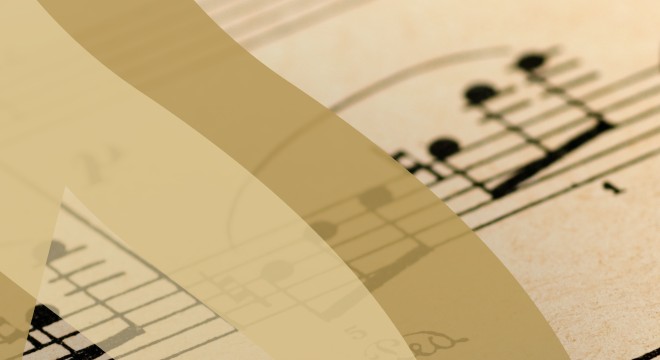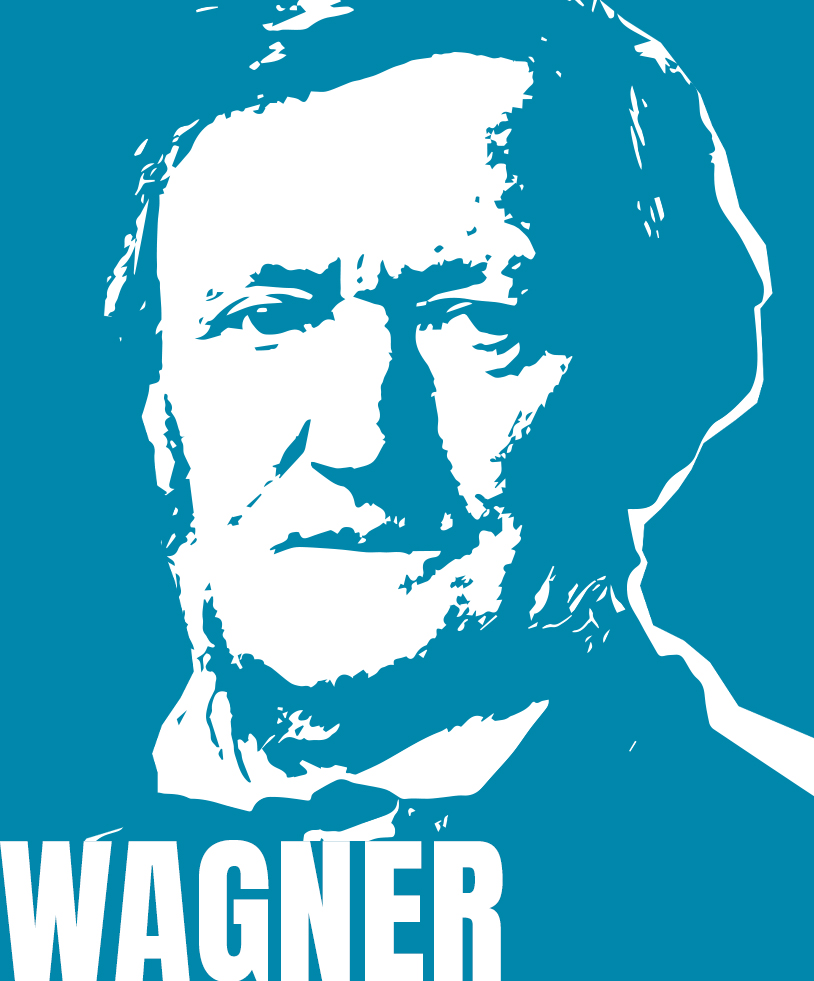Overture to Die Meistersinger
Prelude to Die Meistersinger von Nürnburg Richard Wagner (1813-1883)
By the time Richard Wagner, at age 48, set about composing his only comic opera, Die Meistersinger von Nürnburg (“The Mastersingers of Nuremburg”), he was renowned as a conductor, a philosopher/essayist, a revolutionary (currently in his thirteenth year of exile), and a champion of “the music of the future.”
Wagner wrote almost nothing but opera, and his earlier operas were all epic tragedies based primarily on ancient Teutonic myths. They were filled with murky, heavy, slow music that, more often than not, met with vilification by critics: “These compositions are remarkable only for the absence of everything that has been deemed beautiful in music”; or “…destitute of melody, extremely bad in harmony, utterly incoherent in form and inexpressive of any intelligible ideas whatever.”
Die Meistersinger is Wagner’s answer to these critics. Based not on myth but on history, the light, happy plot weaves a fictional love story into the actual practices of the guilds of 16th-century Nuremburg, focusing on the greatest guild of them all, the Mastersingers. Wagner makes sure that this opera exhibits his brilliance at everything his critics said he couldn’t do. The opera brims with fast, sunny music that remains clearly within a key, develops through traditional forms, and demonstrates a masterly command of the technique dearest to Wagner’s conservative countrymen—counterpoint.
The overture demonstrates all these qualities. It bursts with melodies, each in Wagnerian tradition depicting a particular emotion or character. An opening, majestic Meistersinger procession gives way to woodwinds that sing a theme of awakening love before a cascade of violin sixteenths leads to a brassier, more pompous Meistersinger fanfare. Power and pomp grow until a short statement of love’s passion leads to the first really peaceful moment—the quietly beautiful song, in violins, of young Walther to his beloved Eva. Passion again rises, rudely interrupted by the playful apprentices, who, too immature to have a theme of their own, merely imitate their masters in a puckish woodwind version of the overture’s opening bars. Their staccato mockery grows until their masters, in a grand gesture, sweep them aside with the original stately theme.
Everything subsides as a single stroke on the triangle announces one of the great moments in all of music. Wagner answers his critics with an unsurpassed masterstroke of contrapuntal craft: he restates quietly the three principal themes of the overture, not one after another but simultaneously. (It is considered the supreme feat of counterpoint to create two independent themes, each beautiful on its own, that yield perfect counterpoint when played together. To do that with three themes is simply unheard of.) Here is a decoding for tune detectives: the opening procession serves as foundation in the lowest depths of the orchestra—tuba, bassoon and double bass; Walther’s song to Eva soars in first violin, horn, clarinet and cello; and the brassy Meistersinger fanfare receives, as the procession theme did earlier, the mocking apprentice treatment—fast and staccato in second violins, violas, and the remaining winds. The rest of the overture is a growing profusion of all its themes that climax as cymbals announce a last grand affirmation of pomp and pageantry.
If Wagner is answering his conservative critics musically in the Meistersinger prelude, he is answering them philosophically in the story of the opera. Impetuous young Walther learns in the end that his revolutionary musical ideas become more profound when tempered by respect for the past. And the stuffy Mastersingers learn they must not become so entangled by tradition that they cannot recognize the value of brilliant innovation.
Yes, this is Wagner preaching to those who have criticized him throughout his career. He is telling them, “I believe in (and can compose with all the techniques of) tradition. But you must be open to new ways. And I am the one who will show you those ways.”
~Jere Lantz
Suite from Henry V
Suite from Henry V William Walton (1902-1986)
Needing a heroic image to bolster morale during World War II, Great Britain turned to its most revered military hero as portrayed by their greatest poet in his most unabashedly patriotic play. The result was a lavish technicolor spectacle of Shakespeare’s Henry V, produced and directed by the leading British actor of the time, Laurence Olivier. For the musical score, Olivier turned to William Walton, whom he had met when they were both plying their arts for a film of Shakespeare’s As You Like It in 1936.
Olivier’s brilliant inspiration was to start and end the film in the Globe playhouse, where Shakespeare first produced Henry V in 1599. He was aiming at authenticity in two historical periods—Henry’s early 15th century and Shakespeare’s late 16th. Walton accordingly drew his musical themes from early liturgical chants and folksongs as well as Elizabethan madrigals, arranged powerfully for a modern symphony orchestra.
As the film opens, a flute accompanies a replica of the original 1599 Henry V playbill as it flutters in the wind to fill the screen. A majestic fanfare supports the film credits before the scene shifts to the Globe, where actors and audience hustle and bustle to ready themselves for the performance.
Early in the film Sir John Falstaff, the rotund and witty fellow miscreant of Henry’s youthful pranks (told in the two parts of Shakespeare’s Henry IV), lies on his deathbed. As the old man recalls his painful dismissal from court by his beloved Prince Hal (now King Henry), the strings intone a passacaglia—a baroque form in which a simple bass line repeats over and over (nine times in all), finally rising to the violin as Falstaff’s soul slips away.
The central event of Henry V is the Battle of Agincourt, where the English, outnumbered five to one, defeat the French in one of the most lavish battle scenes ever filmed. The troops gather to fanfares in horns, trumpets and drums. In full armor, the French cavalry charges mightily, only to run into pointed stakes planted by the English and the murderous shafts of Welsh longbows. Mired in the mud of a week’s rain, 10,000 Frenchmen die as an old French ballad, Bailero, is heard mournfully in the English horn.
A second string interlude derives from an earlier scene when Falstaff’s friends, saddened by his death, are spending their last night together before embarking for France and war. The title is taken from a line in the play, and the music, a sad ballad, reflects the double sadness of the moment.
Legend has it (and for once, history agrees) that after the battle Henry and his men sang lustily an improvised song of thanks that has been passed down as one of England’s greatest folk tunes, the Agincourt Hymn. Walton’s suite ends with a grand rendition of that 1415 song, its stately melody in stentorian brass with the rest of the orchestra dancing in joyful tumult.
~Jere Lantz
Symphony No. 2
Symphony No. 2 in D Major, Op. 73 Johannes Brahms (1833-1897)
Brahms’ hesitation to write a symphony is legendary. He had seen too many romantic symphonists fail—in the eyes of the critics, the public and themselves—to live up to the legacy of Beethoven. His earlier orchestral works (two serenades, the First Piano Concerto, the Haydn Variations) demonstrated an ample symphonic prowess. Still, he told friends, “Composing a symphony is no laughing matter,” and “You have no idea of how it feels to hear behind you the tramp of a giant.”
Eventually Brahms had to yield to the inevitable; after working on it for nearly twenty years, Brahms presented, at age 43, his First Symphony. Its moderate success unleashed a flood: a second symphony within a year and two more in the next decade. Though he would write no orchestral works in the final decade of his life, his reputation as the greatest symphonist since Beethoven was assured.
Far more than most symphonists, Brahms captured a different flavor or character in each of his symphonies. The First makes an almost Beethovenian progression from darkness to light. (Indeed, conductor Hans von Bülow dubbed it “The Tenth,” a compliment that cut both ways, confirming Brahms’ fears about “the tramp of a giant.”) The Third is heroic at first, later melodic and finally enigmatic. The Fourth, perhaps the greatest, was called dry at its premiere, but has come to be treasured as a trove of marvelously controlled intensity.
The Second is generally labeled “pastoral,” and it is here that labels show both their logic and their limitations. A gentle opening, with its four-note underpinning in the bass and comforting horn call above, certainly suggests the peace of the countryside. Wanderings high in the violin do nothing to erase this mood, which is enriched by a truly singing second theme in the resonant baritone register of the cellos and violas. A more aggressive third theme and assertive brasses in development and coda serve only to highlight the overall serenity, and the movement ends in pensive calm.
If the first movement cleaves to the pastoral appellation, the second transcends it, striving toward profundity. After its premiere, Viennese critic and Brahms champion Eduard Hanslick wrote:
A broad singing Adagio in B follows, which, as it appears to me, is more conspicuous for the development of the themes than for the worth of the themes themselves. For this reason, undoubtedly, it makes a less profound impression on the audience than do the other movements.
Which is to say, it is less extroverted than its mates. Hanslick identified one of Brahms’ greatest skills—an organic, natural unfolding of a theme’s development. Yet he failed to understand that themes with higher profiles resist such organic development. Though not easy to grasp, even for Hanslick, the Adagio remains one of Brahms’ richest treasures.
As usual, Brahms supplants the conventional rollicking scherzo form with a quiet piece that might be called, as Brahms did in his piano works, an intermezzo. With the reedy oboe giving out a gently rocking melody, the Allegretto grazioso could well be a shepherd’s serenade to his grazing flock. Twice the mood is broken by brief scampers (gamboling sheep?) that hint at a true scherzo, but after every scamper, the serenade resumes, its composure unflappable.
Like the Adagio, the finale marks a departure from pastoral serenity but in the opposite direction. Its opening is more urgent than tranquil, the deliberately quietened (sotto voce) unison reflecting things past (the very opening notes of the symphony) and promising things to come. The continued whispering in quick (Allegro con spirito) tempo builds potential energy that bursts forth with a sudden radiance hitherto unheard in the symphony. One is immediately reminded that D major was to the classical composers the key of victory and joy.
As in the opening movement, a second theme is richer and to be played more broadly (largamente). The initial energy returns, mushrooming to a climax in a marvelous pattern of repeated scales. A brief tranquillo passage in the development recalls erstwhile pastoralism before yielding to the movement’s initial urgency.
A masterly symphonic dramatist, Brahms saves a crowning touch for the coda. Showcasing his powers of transformation, he presents the principal themes of the movement—originally subdued—in exuberant dress. The largamente theme, in fact, becomes a brilliant trumpet call leading to a shattering triad in the trombones as the symphony that began in a “pastoral” mode ends on a note of triumph.
Program Notes by Jere Lantz








